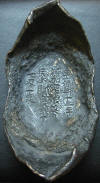Tax Increases during the Late Ming Dynasty
Weight: 1,000 grams/27 taels
Date: 1640 A.D.
Inscriptions: 寧鄉縣(崇禎)十三年新加漕糧募民水腳銀貳十七兩一定
Ning Hsiang County (in Shandong or Hunan Province), the 13th Year (of Chong Zhen), a Lump of 27 Taels "Water Foot" (Freight for the shipment via Grand Canal) Silver Collected from Taxpayers for the Newly Added Taxed Grain to be shipped via Grand Canal.
Military expenses dramatically increased during the last few decades of the Ming Dynasty as the government combatted numerous rebellions breaking out across China. As a result of the spiraling costs, taxes had to be increased.
Reportedly, because of an uprising in Liao Dong (in the northeast China) during the later years of Emperor Wan Li (1573-1620), the Ming government had increased taxes for 9 million taels of silver, and the tax increase was known as "Liao Ration" (遼餉).
In the 2nd year of Chong Zhen (1628-1644), the taxes were once more increased by the government. This tax increase equaled to 2.6 million taels of silver and was known as the "Giao Ration (Pacification Ration)" (剿餉)
Even after the additional taxes were spent on defense, the rebellion continued to gather strength and soon threatened the existence of the empire. Although the Ming dynasty's population was staggering under the burden of the prior tax increase, collecting more tax was the only means to maintain the empire. In the 12th year of Chong Zhen, a new tax increase for 7.3 million taels of silver was imposed, and this tax increase was known as the "Lien Ration (Training Ration)" (練餉). However, it did not help the dying empire survive for much longer. Five years later, the last emperor of the Ming Dynasty Chong Zhen, hanged himself when the imperial palace was lost to to the rebels, and the entire country was soon lost to the new regime, the Ching Dynasty.
The piece shown above represents the receipts from an extra duty imposed on freight shipped to an official warehouse by way of the Grand Canal, rather than revenue raised by a basic tax appearing in the historical record . Obviously, the extra burdens on the taxpayers during the late Ming period were not only the various rations indicated above.
The piece shown above represents the receipts from an extra duty imposed on freight shipped to an official warehouse by way of the Grand Canal, rather than revenue raised by a basic tax appearing in the historical record. Obviously, the extra burdens on the taxpayers during the late Ming period were not only the various rations indicated above.
Return to Sycee Talks
